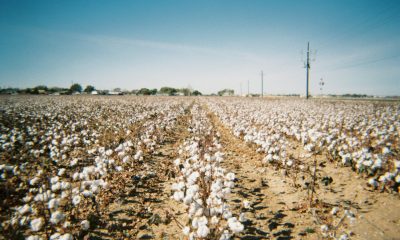Featured
Trends Are Still Mostly Down on the Rice Daily Charts
Rice was sharply lower last week with most of the selling seen in the first part of the week. The weekly export sales report was solid. The USDA WASDE estimates showed 2.0 million cwt less of long grain Rough Rice demand and a corresponding increase in ending stocks. Ending stocks are now estimated at 38.1 million cwt for All Rice and 27/3 million cwt for Long Grain.

Wheat: Wheat markets were a little lower in all three markets in response to another week of poor export sales and unchanged supply and demand estimates from USDA. The WASDE reports showed unchanged demand for US Wheat despite weak export sales so the market started to work lower again in search of the demand in the face of weaker prices in the Black Sea. Demand concerns continue. The demand for US Wheat in international markets has been a disappointment all year and currently is hindered by low and aggressive offers from Russia. Ukraine is also looking for new business for its crops and Russia is aggressive in the world market as it looks for cash to fund the war. The daily charts for the Chicago markets show mixed trends and demand fundamentals remain bearish. Minneapolis trends are mixed. The demand for US Wheat still needs to show up and there is still no demand news to help support futures.
Weekly Chicago Soft Red Winter Wheat Futures
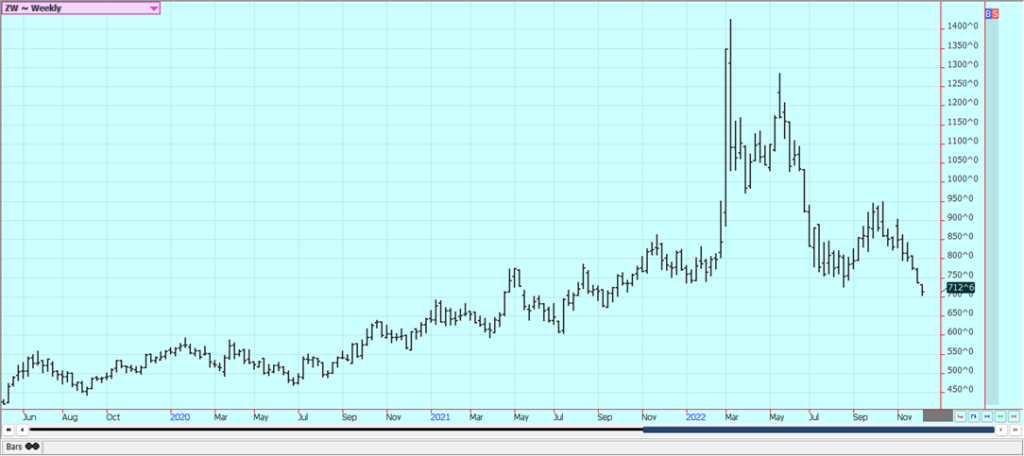
Weekly Chicago Hard Red Winter Wheat Futures
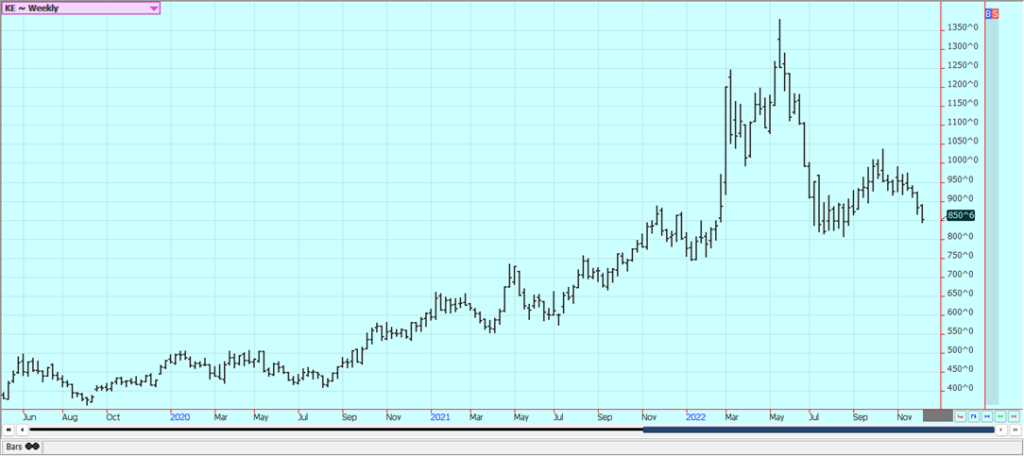
Weekly Minneapolis Hard Red Spring Wheat Futures
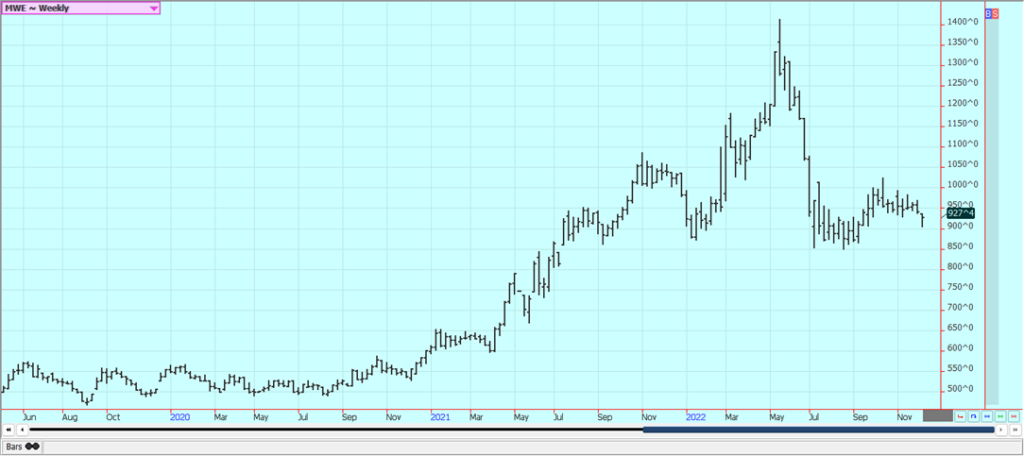
Corn: Corn closed about unchanged and Oats closed higher last week with Corn reacting to the USDA WASDE estimates that were released Friday. USDA cut export demand by 75 million bushels and added the same amount to ending stocks. Ending stocks are now estimated at 1.257 billion bushels. Upside price action was hurt by another week of fewer export sales. Corn prices are still hurt by a general lack of demand. Corn is still finding some support in a lack of farmer selling. Weak demand overall for US Corn remains a big problem for the market. The Mississippi river remains low due to the dry conditions seen in most of the central parts of the US. Barge traffic has been reduced. Some water has been falling in the basin now in the form of rain and snow so conditions should be improving. The proposed EPA Ethanol production mandates released last week were less than expected by the trade and hurt Corn demand ideas There are increasing concerns about demand with the Chinese economic problems caused by the lockdowns creating the possibility of less demand as South America has much better crops this year to compete with the US for sales. China is now moving rapidly to open te economy and allow people to move around with no lockdowns so the demand could start to improve. South American prices are currently cheaper than those in the US.
Weekly Corn Futures
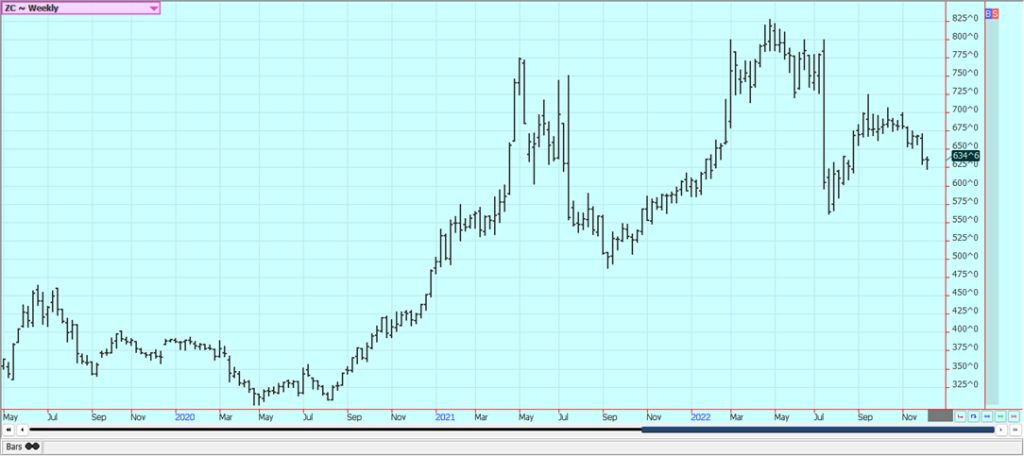
Weekly Oats Futures

Soybeans and Soybean Meal: Soybeans and Soybean Oil closed lower, with Soybean Meal making new contract highs. USDA made no changes in its latest WASDE estimates on Friday and ending stocks were left at 220 million bushels. Trends remain up Soybean Meal and are turning up for Soybeans but are down for Soybean Oil. The big moves came in the Soybean Meal – Soybean Oil spreads, with Soybean Oil collapsing and Soybean Meal moving to new contract highs. The biofuel mandates proposed by EPA last week increase the production of the fuels, but not by as much as the trade had expected. Conditions in Brazil are called very good in central and northern areas but are dry in the south. Production potential for the country as a whole is called very strong. There was news that China has started to ease Covid restrictions after some demonstrations by the Chinese people. Demonstrations were reported in China a week ago due to the Covid lockdowns as some people were killed in an apartment fire. Ideas that Chinese demand will improve and that Brazil growing conditions are good and getting better. However, it remains dry in Argentina and the crops and the planting pace are suffering. Export demand for the US is improved. Domestic demand should be strong for Soybeans as the crush spreads are strong and provided crushers with a big profit margin for their crushing
Weekly Chicago Soybeans Futures:
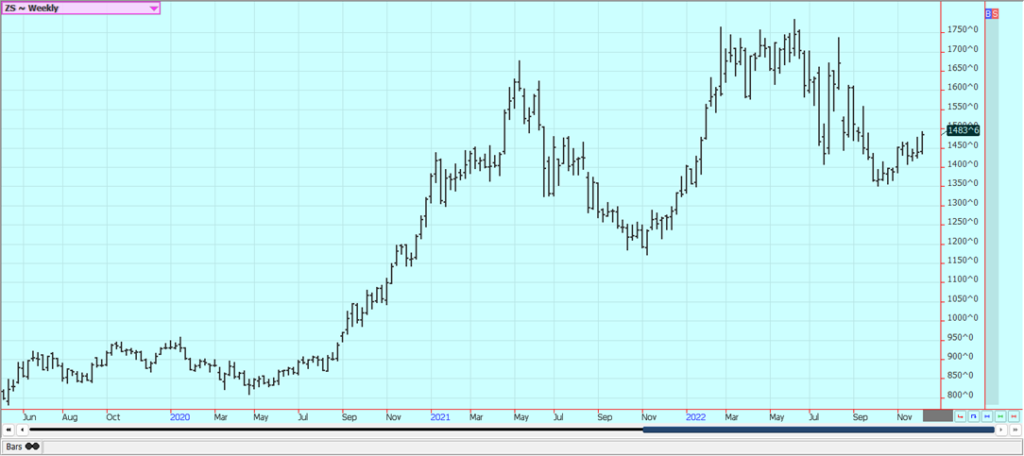
Weekly Chicago Soybean Meal Futures

Rice: Rice was sharply lower last week with most of the selling seen in the first part of the week. The weekly export sales report was solid. The USDA WASDE estimates showed 2.0 million cwt less of long grain Rough Rice demand and a corresponding increase in ending stocks. Ending stocks are now estimated at 38.1 million cwt for All Rice and 27/3 million cwt for Long Grain. There is not much going on in the domestic market right now. Trends are still mostly down on the daily charts. Some new Rice producer selling might be found soon as futures and basis are now getting close to being profitable for producers to sell. Most Rice farmers were not paying much attention to the market as they are involved in other pursuits such as hunting. Demand in general has been slow to moderate for Rice for both exports and domestic uses.
Weekly Chicago Rice Futures
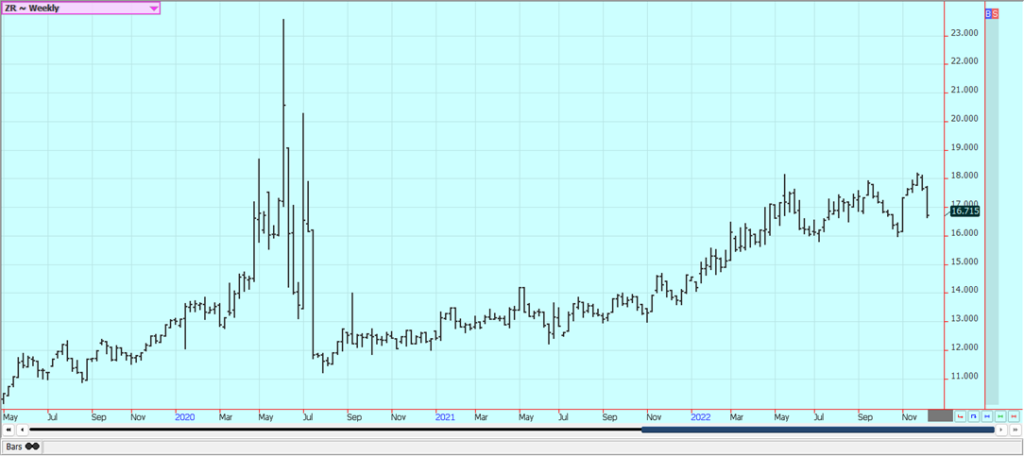
Palm Oil and Vegetable Oils: Palm Oil closed higher on Friday and slightly higher last week. Hopes for improved demand from China were reported but export demand overall has improved lately. China has tried to relax some Covid restrictions so that quarantines now need to be eight days instead of at least two weeks. However, new outbreaks of the virus are being reported so the cities are still imposing lockdowns. Ideas are that supply and production will be strong, but demand ideas are now weakening and the market will continue to look to the private data for clues on demand and the direction of the futures market. Demand reports for the current month were stronger yesterday. Canola was higher aa well last week. News of less than expected bio fuels mandates from EPA and on n ideas that Chinese demand can remain weak due to increased outbreaks of Covid there were negative. Demand for export has been less. Farmers are holding tight to harvested supplies. Reports indicate that domestic demand has been strong due to favorable crush margins. Production was much improved this year on better weather during the Summer.
Weekly Malaysian Palm Oil Futures
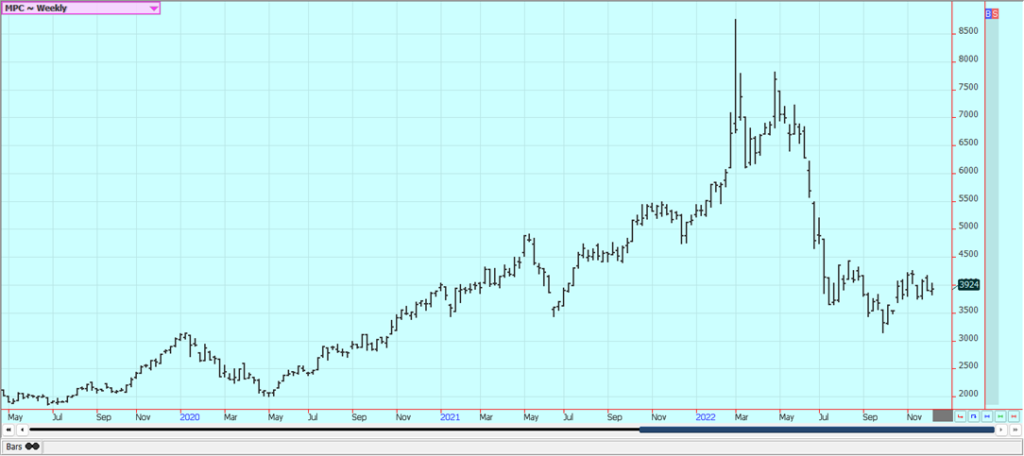
Weekly Chicago Soybean Oil Futures
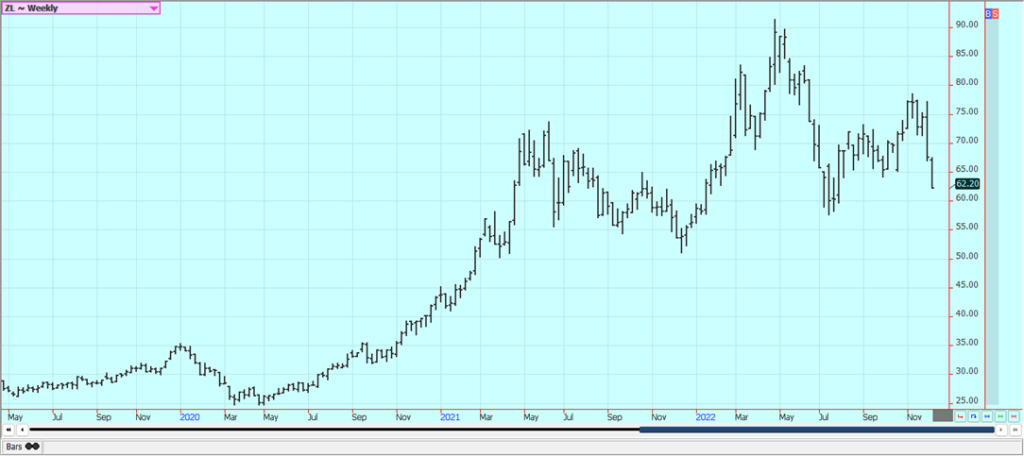
Weekly Canola Futures:

Cotton: Cotton was lower last week despite some ideas that demand could soon increase as China could start to open its economy in the next couple of months. Demand has not been real strong so far this year and the weekly export sales report was bad once again. Demand has not improved with the reduction in prices and a lower US Dollar to date. USDA released its monthly supply and demand estimates on Friday and increased production while cutting back on both domestic and world demand. Ending stocks were increased to 3.50 million bales from 3.00 million last month. World-ending stock levels also increased and are now at 89.56 million bales. China had been making some initial moves to open its economy and country again but many cities remain in lockdown due to an increase in Covid infections. China saw protests that were sparked by the deaths of several apartment dwellers in a city that protesters said was locked and on lockdown status. There are reports that China has ended its zero-tolerance Covid policies and is allowing for greater freedom by citizens. Production in the US is very short.
Weekly US Cotton Futures
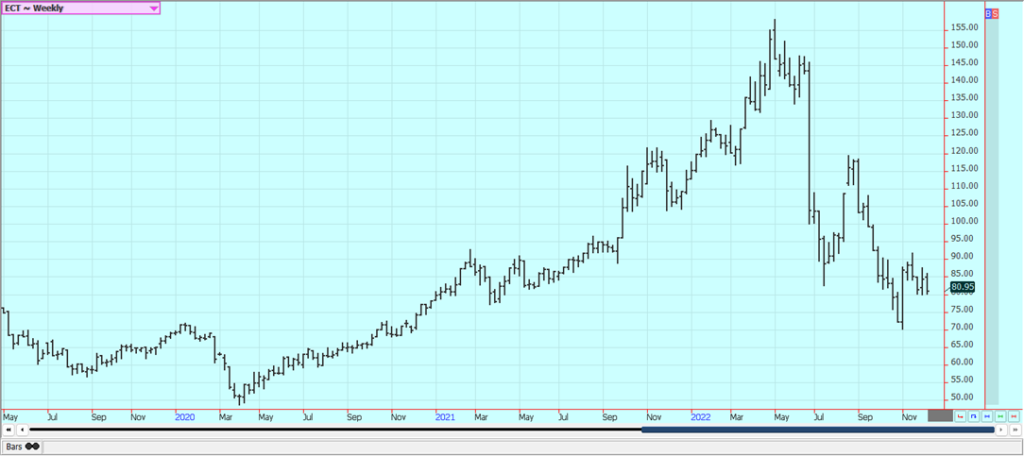
Frozen Concentrated Orange Juice and Citrus: FCOJ was lower last week on what appeared to be speculative selling. Historically low estimates of production due in part to the hurricanes and in part to the greening disease has hurt production remain in place but are apparently part of the price structure now. The weather remains generally good for production around the world for the next crop but not for production areas in Florida that have been impacted in a big way by the two storms. Brazil has some rain and the conditions are rated good. Mostly dry conditions are in the forecast for the coming days. Florida Citrus said that FCOJ inventories re now 40.3% below last year.
Weekly FCOJ Futures

Coffee: New York and London closed a little higher last week. Ideas of reduced Brazil production and reports of reduced offers into the cash market from Brazil and Vietnam continue, but the weather is good in Brazil and improving in Vietnam. There are ideas that the production potential for Brazil had been overrated and reports of too much rain in Vietnam affecting the harvest progress. The weather in Brazil is currently very good for production potential but worse conditions seen earlier in the growing cycle hurt the overall production prospects as did bad weather last year. Weather conditions are good in Brazil and the rest of Latin America and supplies available to the market should keep increasing and the market is looking forward to the increased supplies. Vietnam’s weather is improved now with less rain reported. Ideas are that the market will have more than enough Coffee when the next harvest comes in a few months. Ideas of a significant recovery in world production next year remain the main cause for any selling. Indonesia Sumatra Coffee exports were 32,290 tons in October, up 15.7% from last month but down almost 40% from September. Colombia produced 1.06 million bags of Coffee in November, down 6% from last year due to big rains. Vietnam Coffee is now about 60% harvested with quality concerns being mentioned due to big rains seen earlier in the harvest period.
Weekly New York Arabica Coffee Futures
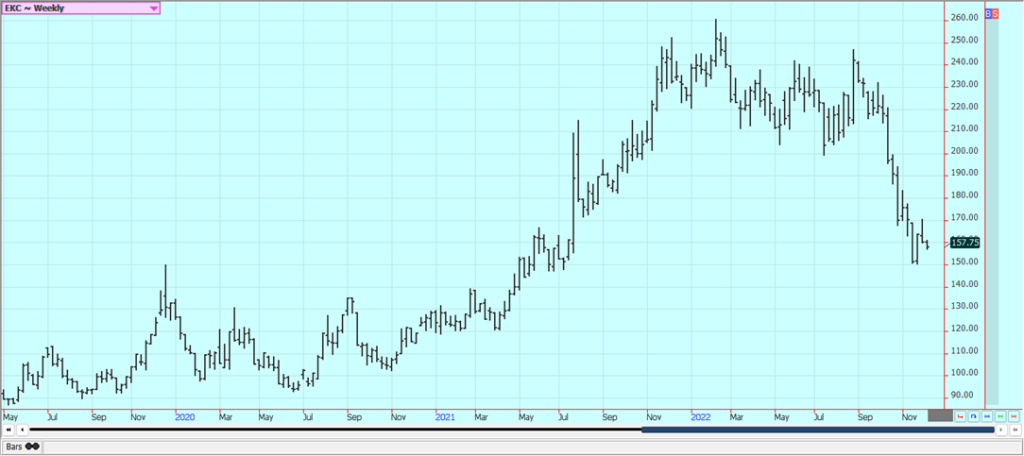
Weekly London Robusta Coffee Futures
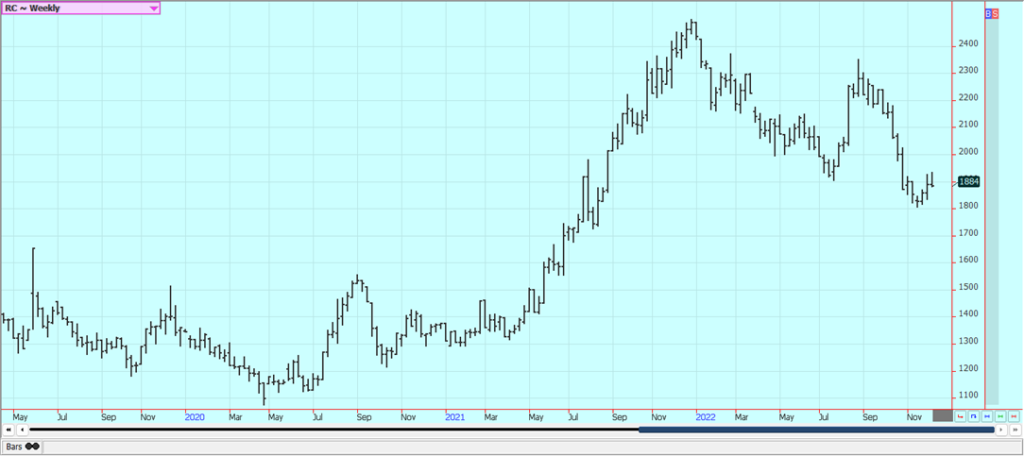
Sugar: New York and London closed higher last week as traders remain concerned about ongoing rains in Brazil production areas. The harvest has also been delayed in Thailand. The weather in Brazil remains good for the next crop but bad for harvest and loading at ports as it is still raining in production areas. Some flooding rains have been reported in some areas and some roads to the ports have been blocked by landslides caused by the rains. World Sugar is expected to be in a big surplus production next year. The supply is starting to increase. Brazil Sugar offers are increasing on ideas of unprofitable Ethanol prices coming to the country and reports of increased use of Corn for Ethanol production Crude Oil futures rallied late last week to help support Ethanol and bio fuels demand ideas. Indian exporters continue selling into the world market but might have less that 1.0 million tons available for export under the current quota. The erratic weather in India seen earlier in the year could have cut production and total production could be 7% less than originally expected.
Weekly New York World Raw Sugar Futures

Weekly London White Sugar Futures
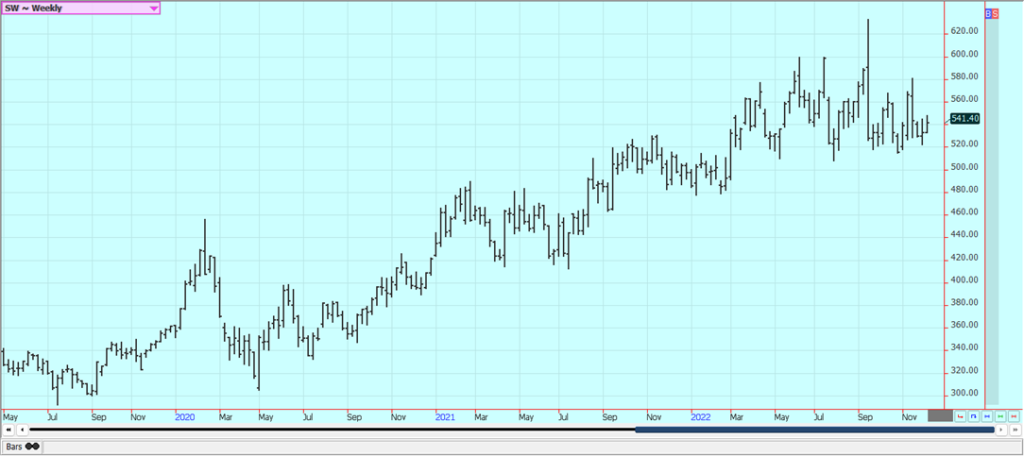
Cocoa: New York closed higher last week and London was lower, with London seeing a lot of selling on Friday. Ivory Coast arrivals appear to have improved lately with the recent rally in futures prices. Ivory coast arrivals are now 718,000 tons, up 1.1% from last year. Ivory Coast arrivals at ports are now 838,000 tons, up 6% from last year. Good production is reported and traders are worried about the world economy moving forward and how that could affect demand. Supplies of Cocoa are as large as they will be now for the rest of the marketing year. Reports of scattered showers along with very good soil moisture from showers keep big production ideas alive in Ivory Coast. The weather is good in Southeast Asia.
Weekly New York Cocoa Futures
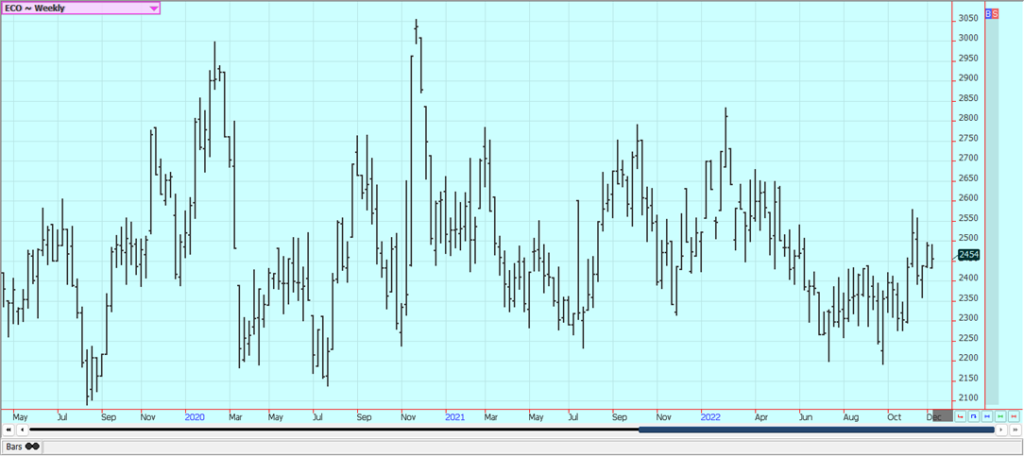
Weekly London Cocoa Futures
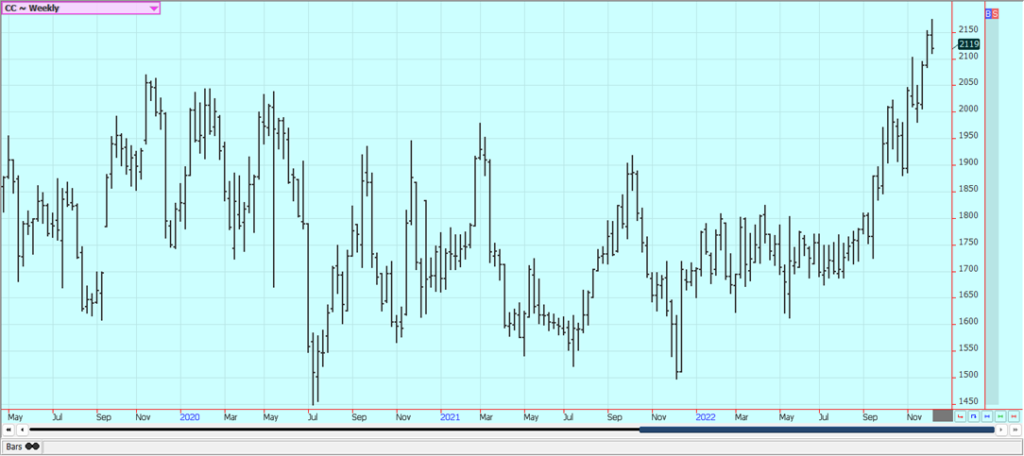
__
(Featured image by TranDuyet via Pixabay)
This article may include forward-looking statements. These forward-looking statements generally are identified by the words “believe,” “project,” “estimate,” “become,” “plan,” “will,” and similar expressions. These forward-looking statements involve known and unknown risks as well as uncertainties, including those discussed in the following cautionary statements and elsewhere in this article and on this site. Although the Company may believe that its expectations are based on reasonable assumptions, the actual results that the Company may achieve may differ materially from any forward-looking statements, which reflect the opinions of the management of the Company only as of the date hereof. Additionally, please make sure to read these important disclosures.
Futures and options trading involves substantial risk of loss and may not be suitable for everyone. The valuation of futures and options may fluctuate and as a result, clients may lose more than their original investment. In no event should the content of this website be construed as an express or implied promise, guarantee, or implication by or from The PRICE Futures Group, Inc. that you will profit or that losses can or will be limited whatsoever. Past performance is not indicative of future results. Information provided on this report is intended solely for informative purpose and is obtained from sources believed to be reliable. No guarantee of any kind is implied or possible where projections of future conditions are attempted. The leverage created by trading on margin can work against you as well as for you, and losses can exceed your entire investment. Before opening an account and trading, you should seek advice from your advisors as appropriate to ensure that you understand the risks and can withstand the losses.

-

 Biotech1 week ago
Biotech1 week agoBiotech Booster: €196.4M Fund to Accelerate Dutch Innovation
-

 Business5 hours ago
Business5 hours agoThe TopRanked.io Weekly Affiliate Marketing Digest [The Top VPN Affiliate Programs Roundup]
-

 Crypto1 week ago
Crypto1 week agoBitcoin Traders Bet on $140,000: Massive Bets until September
-

 Crypto2 weeks ago
Crypto2 weeks agoCaution Prevails as Bitcoin Nears All-Time High






